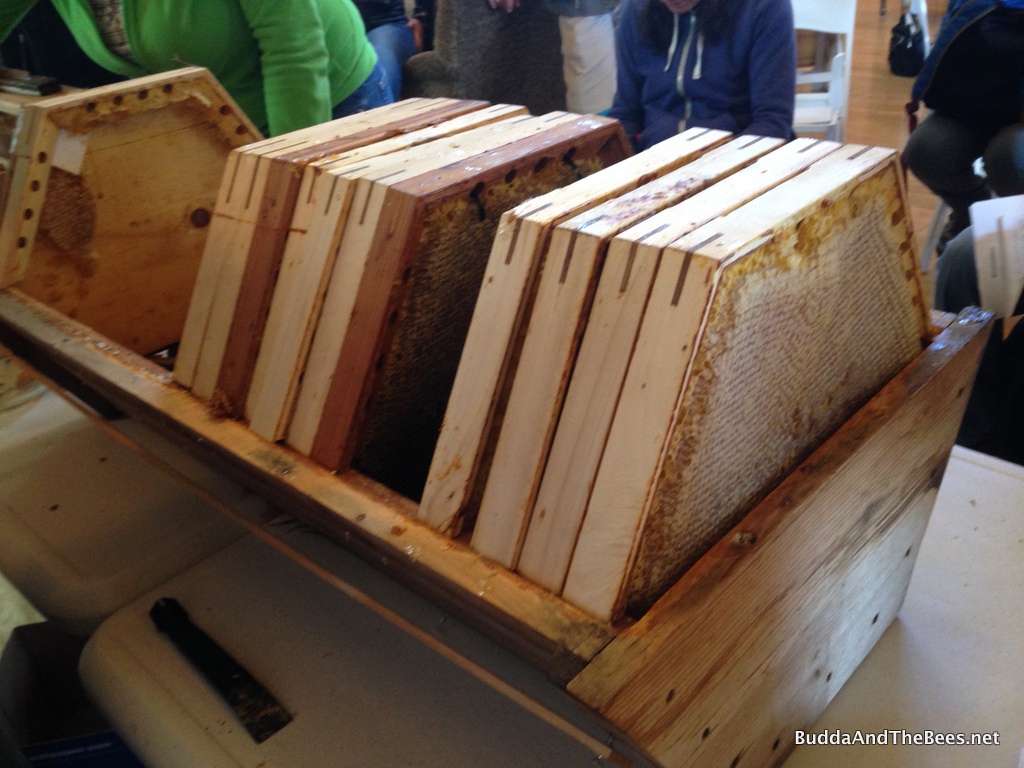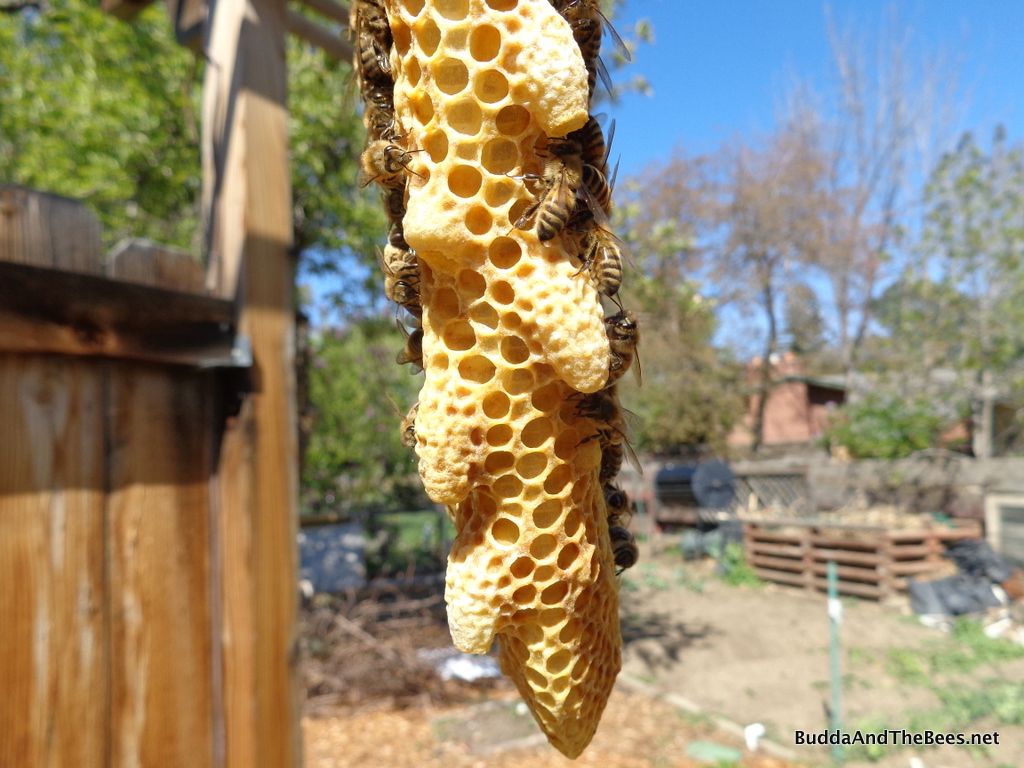The varroa mite (aptly named varroa destructor) is a parasitic mite that attacks honey bees. It attaches to the bee larva while it’s developing and feeds on the bee’s “blood” (hemolymph). This weakens the bee and makes it susceptible to infections and diseases. Originally from Asia, it came to the U.S. in 1987 and has spread across the land. A severe infestation is usually a death sentence for a colony. Initially, the European honey bee (Api mellifera) was defenseless against the varroa and many managed and feral hives were wiped out. In recent years, honey bees have have been bred for Varroa Sensitive Hygiene (VSH) traits which produces bees that are better at grooming off mites and removing infected larva so the mites can’t reproduce.

Varroa Destructor
Beekeepers square off in separate camps in relation to the varroa. Some beekeepers insist that you have to monitor and treat for mites if you want your bees to survive. Treatment can consist of either passive (screened bottom boards which allows the mites to drop out of the hive) or active (putting a variety of different chemicals into the hive which kill the mites, but hopefully not the bees) methods. On the other end of the spectrum is the treatment-free camp, which tries to use natural selection and the bee’s own VSH traits to co-exist with the mites. Those colonies that can deal with the mites survive, for the rest, it’s adios! The real adherents don’t even count mites to see if there is a problem – they just let nature take it’s course – breeding the queens that survive. On most of my hives, I have screened bottom boards and until now, I’ve done nothing active to treat for mites. I occasionally check my mite boards to see how many there are, but most of the time I don’t worry about this. I suspect that BnB1 died this past year because it had mites that reduced the population beyond a viable count to make it through the winter.
A couple of weeks ago, I looked at the mite board under BnB1 and noticed that there were hundreds of mites on the board. Ideally, you put the board in under the screened bottom for 3 days and then count the mites. You divide by 3 to get the number of mites falling off bees/day. A number less than ten means that things are probably under control, but over ten you need to start worrying about whether to treat or not. I probably had 50 per day on the board. That was bad. In contrast, BnB2 had one mite after a week.
When I went in and inspected BnB1, I got even more of a surprise. There was no new brood – no eggs, larva or capped) and only a handful of older capped brood cells on a couple of combs. This indicated that the queen was no longer there. There were some bees with deformed wing virus (typical in a mite infestation), but not as many as I was expecting.
There were still a lot of worker bees, lots of honey and pollen and the foragers were still bringing in pollen and nectar. So, other than no queen/brood, the hive looked good! However, without a queen and brood, and with lots of mites, it was a gonner. Like Jon Snow says, “Winter is coming” and a new queen would have to have time to build up enough winter workers to make it through.
I sent a note out to the local beekeepers list explaining the situation and asking if it was too late to put a new queen in. I got back mostly bad news – let them die, it’s too late in the season, the mites have won. However, Miles McGaughey, president of the Boulder County Beekeepers Association offered to come over and do an inspection. He confirmed that the colony was queenless, but thought a new queen could make it if the mites were controlled. Dean Chapla offered up a free queen that his bees had raised outside his queen rearing operation (naturally mated).
But what to do about the mites? The least chemically invasive treatment is to dust the hive with powdered sugar. The bees would clean themselves of the sugar and in the process would dislodge mites. However, that doesn’t get the mites that are in the brood and I had too many mites for this to be effective. I was in luck, since I had no new brood there wasn’t anything for the mites to reproduce on. But they don’t die off immediately and when Miles and I were looking through the hive, we saw a bunch of them hiding in empty cells. So, I had to do something before putting a new queen in.
Miles suggested using Mite-Away Quick Strips (MAQS), which is formic acid – a substance found naturally in honey – since I could get it locally. However, it needs to be used when the temperatures are under 85 and we had been in the 90’s for the last month. The next few days were going to be right around 85, so I had a window and Dean thought I only needed to treat for a few days (instead of the normal 7) since I had no brood. Normally, I try to be as “treatment-free” as I can and this was not something I would naturally consider. However, there were so many workers still in the hive, I hated to just give up and since I had a free queen to use, I thought what the heck!
When I was buying the MAQS at Harlequin Gardens, the lady there said to be careful when opening the package because the fumes could be overwhelming. Reading the instructions, it didn’t sound like it was something you’d find naturally in honey – caution about skin contact, dispose as hazardous waste, etc. Did I really want to put this on my hive?
For a Langstroth hive, the procedure is pretty simple. You place a couple of strips on top of the bottom brood box and then put the other box on top. Formic acid is heavier than air, so it drifts down over the brood, killing the mites. In a top bar hive, there is no gap between the bars from above, so it’s a little trickier. Miles suggested a setup where I make a gap smaller than the width of a bee between the bars, set the strips on top, and cover them with a plastic tub, which is what I did. The lady at Harlequin’s was right – I was almost overwhelmed by the smell when I opened the package, but luckily I knew that was coming.
I let it go for 4 days, flirting with temperatures in the 90’s on the last couple of days. During this time, robber bees started attacking the hive (they can smell weakness, I think), so I put a screen over the front to keep them out. You need to have the entrance fully open for the treatment, so I couldn’t put on an entrance reducer. When it was all over, I got the new queen from Dean, took a couple of combs of brood from BnB2 (making sure not to get move her queen too) and put them in BnB1. By that time, there weren’t as many bees left in BnB1. The queen was in her cage, so I had to release her a couple of days later. I’ll check on Labor Day to see if she’s started laying – she looked good and healthy when I released her into the hive.
Who knows if this will all work. I look at it as another experiment in my beekeeping adventure. I know I don’t ever want to use formic acid again and if I had the same situation again, I’d probably just cut my losses.







4 Comments
Julie · September 5, 2015 at 2:45 pm
Ugh. So sorry about BnB1. It’s heartbreaking to watch a hive decline, and that’s a lot of mites. By any chance, did she get a brood break this year?
CT just approved Hopguard II, but I don’t know anyone who’s used it yet. Supposedly, it can be used on brood as well as bees and has negative effect on queen laying.
You know I’m in the TF camp, but it seems you made a really smart compromise. The old queen was gone anyway, and so were here genetics. So it seems logical to get rid of enough mites that you could bring in a new queen with different genetics. At least you don’t lose everything that way. Fingers crossed that they rebound before winter.
Don · September 5, 2015 at 3:03 pm
The only brood break was when she left/died. 😉 Like I said, if there were only a handful of bees left when I started this, I would have just let them die. But given the numbers, I figured I’d take a chance. I was really impressed with how the new queen looked – big and plump, so I hope she can start laying quickly to get the numbers up!